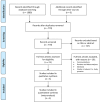Association of liver dysfunction with outcomes after percutaneous coronary intervention - a systematic review and meta-analysis
- PMID: 39434009
- PMCID: PMC11492513
- DOI: 10.1186/s12872-024-04252-9
Association of liver dysfunction with outcomes after percutaneous coronary intervention - a systematic review and meta-analysis
Abstract
Background: Liver dysfunction is a known risk factor in the cardiovascular field. It specifically increases perioperative risk in patients undergoing coronary bypass surgery. Since percutaneous coronary intervention (PCI) is the much less invasive procedure for the treatment of coronary artery disease, we aimed to assess the relationship of liver dysfunction with outcomes in patients undergoing PCI.
Methods: Three libraries were searched (MEDLINE, Web of Science and The Cochrane Library). We performed a meta-analysis of all studies in patients who underwent PCI that provided information on the presence or absence of liver dysfunction. Primary outcome was short-term mortality. Secondary outcomes were major adverse cardio- and cerebrovascular events (MACCE), bleeding and acute kidney injury. Random-effects model was applied.
Results: Five studies were selected and the data from 10,710,317 patients were included in the final analysis. In comparison with the absence of liver dysfunction, patients with liver dysfunction were associated with higher short-term mortality (OR 2.97, 95%CI 1.23-7.18, p = 0.02), higher MACCE (OR 1.42, 95%CI 1.08-1.87, p = 0.01), and higher bleeding (OR 2.23, 95%CI 1.65-3.00, p < 0.01). There was no significant difference regarding acute kidney injury (OR 1.20, 95%CI 0.50-2.87, p = 0.69).
Conclusions: The analysis suggests that liver dysfunction in patients undergoing PCI is independently associated with higher risk of short-term mortality and increased occurrence of MACCE and bleeding. However, there appears to be no association to acute kidney injury.
Keywords: Coronary artery disease; Liver dysfunction; Percutaneous coronary intervention.
© 2024. The Author(s).
Conflict of interest statement
The authors declare no competing interests.
Figures






References
-
- Asrani SK, Devarbhavi H, Eaton J, Kamath PS. Burden of liver diseases in the world. J Hepatol. 2019;70:151–71. - PubMed
-
- Younossi ZM, Koenig AB, Abdelatif D, Fazel Y, Henry L, Wymer M. Global epidemiology of nonalcoholic fatty liver disease-Meta-analytic assessment of prevalence, incidence, and outcomes. Hepatology. 2016;64:73–84. - PubMed
-
- EASL-EASD-EASO. Clinical practice guidelines for the management of non-alcoholic fatty liver disease. J Hepatol. 2016;64:1388–402. - PubMed
-
- O’Brien SM, Feng L, He X, et al. The Society of thoracic surgeons 2018 adult cardiac surgery risk models: part 2-Statistical methods and results. Ann Thorac Surg. 2018;105:1419–28. - PubMed
Publication types
MeSH terms
LinkOut - more resources
Full Text Sources
Medical
Miscellaneous

